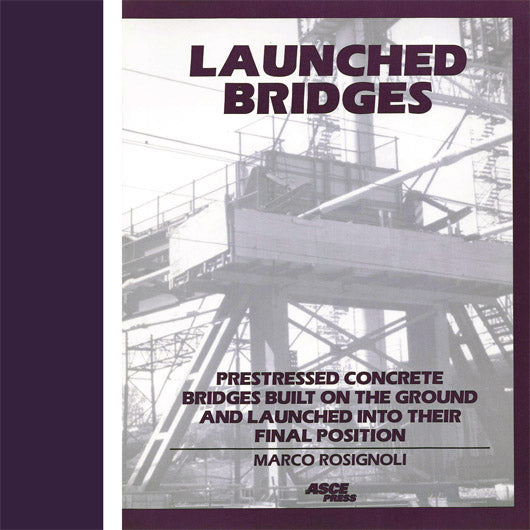
Launched Bridges
Marco Rosignoli
ASCE Press, ISBN 0784403147 (1998), p.363, sold out.
In 1998, Launched Bridges was the first book ever written on the incremental launching construction of prestressed concrete bridges. It took me 15 years to write it, during hundreds of weekends and most of my long-haul flights, summarizing the experience earned from the design and construction of launched bridges in Europe.
Launched Bridges shares one particularity with my other books: it is entirely original - the first books ever written on that topic. Writing technical books takes a lot of work and passion, and dealing with unexplored topics is even harder. You have to start from scratch, investigate the subject, find how to solve its challenges, organize hundreds of pages and illustrations into a logical structure, convince a prestigious publisher that the topic deserves its attention, and go through an accurate process of peer review.
Published in 1998 by ASCE Press, the American Society of Civil Engineers, the book sold out in a few months. I have many nice memories about that book, and a congratulation letter written by Prof. Leonhardt that I am proud to showcase in my bookshelf.
Launched Bridges was the first book entirely devoted to the art and science of bridge launching. It integrates the static, aesthetic and economic aspects of construction techniques for building state-of-the-art structures. A comprehensive handbook, it offers explanation of the theoretical and technological aspects of the construction process.
Brand-new analysis methods for optimizing structural design and launch stress distribution were developed and independently reviewed. I applied the Transfer Matrix Method to the parametric launch stress analysis of steel and prestressed-concrete bridges, and then I developed the Reduced Transfer Matrix (RTM) method to perform the launch stress analysis with a spreadsheet. Implementing the RTM method with a spreadsheet just takes a few days of work. From that point on, regardless of the computing speed of modern processors, running a full-blown parametric launch stress analysis in a couple of seconds instead of some days makes a big difference, especially when you have to compare alternatives. In 1998, the difference was huge.
The book describes the history of the incremental launching method and its evolution into three construction methods: continuous casting combined with incremental launching, balanced cantilever casting combined with symmetrical launch or rotation, and casting on falsework followed by side skidding. Twenty years later, these methods are still state-of-the-art. It is not unusual that attendees of my bridge courses be so surprised by what was done in the 90s in the field of bridge launching.
Launched Bridges examines construction methods for bridge segments, launch techniques, and equipment. It explores geometry requirement, the launch of cable-stayed decks, and deck launching over arches. Deck segmentation and cage prefabrication are discussed in relation to the design of launch post-tensioning, the cycle time of segment production, and the distribution of the segment curing supports between the casting cell and the launch abutment. Special design methods address optimization of launch noses and front cable-stayed systems and the deck itself. Deck pre-sizing, loading of temporary and final piers, and the techniques of verifying the design assumptions by means of field monitoring and data recording, are also examined.
- Launched Bridges is the most complete presentation of this construction method for concrete bridges even including composite structures. The bibliography with 230 references shows the amount of work to assemble all this knowledge. I congratulate you for this work - Fritz Leonhardt, Prof.Em., Dr.Ing., Leonhardt, Andrae und Partners (Germany)
- The research and practical work of Marco Rosignoli have been enormously influential in diffusing the use of the incremental launching method in Europe - Paolo Napoli, Prof.Ing., Dr.Ing., Professor of Structural Engineering, Politecnico di Torino (Italy)
- Launched Bridges and Bridge Launching are the first (and the only) books ever written on the topic, and they are full of precious design and technological information. They are "the bible" for bridge launchers - Telemachos Tsiknias, PhD, PE, Chief Executive Officer, TTA (Greece)
The book examines thrust systems and launch bearings and guides, and provides a close-form approach to analyze the effects of misaligned launch bearings. It also provides exhaustive coverage of the analysis of launch forces and reactions and the use of rear noses for the final launch stages.
Launched Bridges includes an entire chapter on the prestressed composite bridges with steel corrugated-plate webs. Twenty years later, these decks still are the most advanced application of incremental launching technology. In 1998, the book offered the very first comprehensive treatment of the topic.
The book exemplifies how comprehensive understanding and proper coordination leads to success in building high-tech bridges. The book was an essential tool for building contractors, technical and design engineers, and bridge owners, besides being the first book ever written on the topic. In 2002, Bridge Launching integrated and expanded Launched Bridges under many points of view, and provided full coverage of the incremental launching construction of steel bridges as well.
